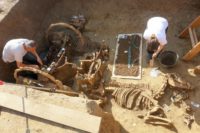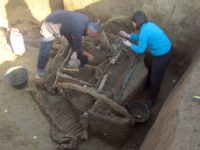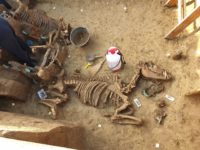 In a first for the country, archaeologists have unearthed an extraordinary complete chariot burial with two harnessed horses near Vinkovci in eastern Croatia. The metal parts of the two-wheeled chariot and the horses’ fittings date the burial to the 3rd century A.D. and it must have belonged to an extremely wealthy individual with a prominent position in the Roman administration of Pannonia. It was discovered in a tumulus about 130 feet in diameter but only three feet high due to centuries of erosion.
In a first for the country, archaeologists have unearthed an extraordinary complete chariot burial with two harnessed horses near Vinkovci in eastern Croatia. The metal parts of the two-wheeled chariot and the horses’ fittings date the burial to the 3rd century A.D. and it must have belonged to an extremely wealthy individual with a prominent position in the Roman administration of Pannonia. It was discovered in a tumulus about 130 feet in diameter but only three feet high due to centuries of erosion.
 This is not only the sole chariot burial ever archaeologically excavated in Croatian soil, but it’s also the easternmost burial mound. It was located along one of the most important Roman roads in the empire connecting the Italy to Pannonia and the Balkans to Asia Minor and has been documented in archaeological literature for 100 years. The family interred there built it to as a monument that conveyed their wealth and importance to all who passed on that busy thoroughfare.
This is not only the sole chariot burial ever archaeologically excavated in Croatian soil, but it’s also the easternmost burial mound. It was located along one of the most important Roman roads in the empire connecting the Italy to Pannonia and the Balkans to Asia Minor and has been documented in archaeological literature for 100 years. The family interred there built it to as a monument that conveyed their wealth and importance to all who passed on that busy thoroughfare.
The Roman town of Cibalae (modern-day Vinkovci) was an important one in imperial Rome. Founded as part of the Roman push to secure the Danube border, it was granted municipium status under Hardrian (r. 117-138 A.D.) and the status of colony (Colonia Aurelia Cibalae) under Caracalla (r. 196-217 A.D.). In the 4th century it was the birthplace of not one but two Roman emperors, brothers Valentinian I (321-375 A.D.) and Valens (328-378 A.D.).
 It is no surprise that such an unmistakable feature on the landscape was struck by looters, but thankfully by lazy ones who never got to the exceptional chariot burial. They contented themselves with pillaging the two central graves which contains the skeletal remains of a man and a woman and were surely replete with valuable grave goods. The remains of a cremation and inhumation burials were also found in the embankment of the tumulus.
It is no surprise that such an unmistakable feature on the landscape was struck by looters, but thankfully by lazy ones who never got to the exceptional chariot burial. They contented themselves with pillaging the two central graves which contains the skeletal remains of a man and a woman and were surely replete with valuable grave goods. The remains of a cremation and inhumation burials were also found in the embankment of the tumulus.
”This is a sensational, unique discovery in Croatia, as this is the first time in our country that this complex funeral custom from the times of Antiquity has been archaeologically investigated and documented.
Now, the long process of restoration and conservation follows, but so does the complete analysis of what’s been found. I hope that in a few years we’ll know more about the family whose members were buried in this area all that time ago, 1,800 years ago.
We’re also more interested in the horses themselves, that is, whether they were bred here or came from other parts of the empire, and what will tell us more about the very importance and the level of wealth of this family. We will achieve this through cooperation with domestic as well as numerous European institutions,” said Marko Dizdar, Director of the Institute of Archeology.
Beyond reasonable doubt, we are talking here about two metric horsepowers :yes:
To the best of my knowledge, chariot burials are not a particularly Roman tradition, i.e. only very early and very Etruscan Romans got chariots and horses in their graves. Secondary burials in tumuli (or ‘Gomila’), on the other hand, are not entirely unheard of, ..which -of course- raises the question: Where is the deceased himself?
That a chariot found in what today is Croatia would be a Roman one, however, makes indeed sense. Contrastingly, there were Greek colonists and the Danube cultures, so it is highly likely that those people had chariots long before the Romans had any.